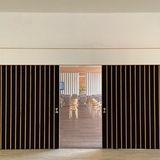В 1960 г., следуя общеамериканскому курсу на удвоение нажитого, известная нам американская ассоциация производителей фанеры (Douglas Fir Plywood Association) выпустила брошюру, в которой постулировала, что каждой семье требуется два дома: «один для жизни в будние дни, а второй – для истинного отдыха». Одним из вариантов второго жилища, предлагавшихся читателям и реализованных при помощи фанеры, был дом на берегу пролива Хейла в штате Вашингтон, спроектированный известным нам Хенриком Буллом, перед которым была поставлена задача «построить загородный дом по цене второго автомобиля».
Булл и этот дополнительный дом площадью 90 кв. м. разделил на два блока: общий, с кухней и гостиной, и частный, с двумя спальнями и санузлом. Терраса, соединявшая оба блока, была перекрыта двускатной крышей, матерчатая кровля которой легко сворачивалась, и могла использоваться в качестве мангальной зоны или даже для размещения гостей (правда, в спальных мешках). А собрать такой дом без утепления и установки септика стоило 3 200 долларов, что составляло примерно половину от среднего семейного дохода за год.
P.S. С другими проектами летних домов из фанеры можно ознакомиться по этой ссылке: https://archive.org/details/SecondHomesForLeisureLiving/mode/2up
———
In 1960, when the American nation was busy doubling their real estate and other assets, Douglas Fir Plywood Association published a promotional booklet and postulated that “every family needs two homes! …one for the work week, the other for pure pleasure”. The booklet featured eighteen remarkable plywood cabins including one designed by Henrik Bull and built in Hale Passage, Washington.
Interestingly, Bull, whom we already know from a couple of other cabin designs and who was tasked with building a cabin “for the cost of a second car”, opted for splitting this 90 sq. m. second home into two units, one with private quarters (two bedrooms and a bathroom) and the other with a kitchen and living room. The sundeck that connected the units was covered with a convertible pitch roof made of canvas and was to include a barbecue area and accommodate additional guests in sleeping bags, if necessary. The cost of assembling this second home (albeit with no insulation or septic tank) amounted to USD 3,200 which translated into half of an average annual family income in 1960.
P.S. Other designs in this booklet, which are just as inspiring, can be found here: https://archive.org/details/SecondHomesForLeisureLiving/mode/2up
(photos: Flickr user MidCentArc, archive.org, grainedit.com, tahoequarterly.com)
Булл и этот дополнительный дом площадью 90 кв. м. разделил на два блока: общий, с кухней и гостиной, и частный, с двумя спальнями и санузлом. Терраса, соединявшая оба блока, была перекрыта двускатной крышей, матерчатая кровля которой легко сворачивалась, и могла использоваться в качестве мангальной зоны или даже для размещения гостей (правда, в спальных мешках). А собрать такой дом без утепления и установки септика стоило 3 200 долларов, что составляло примерно половину от среднего семейного дохода за год.
P.S. С другими проектами летних домов из фанеры можно ознакомиться по этой ссылке: https://archive.org/details/SecondHomesForLeisureLiving/mode/2up
———
In 1960, when the American nation was busy doubling their real estate and other assets, Douglas Fir Plywood Association published a promotional booklet and postulated that “every family needs two homes! …one for the work week, the other for pure pleasure”. The booklet featured eighteen remarkable plywood cabins including one designed by Henrik Bull and built in Hale Passage, Washington.
Interestingly, Bull, whom we already know from a couple of other cabin designs and who was tasked with building a cabin “for the cost of a second car”, opted for splitting this 90 sq. m. second home into two units, one with private quarters (two bedrooms and a bathroom) and the other with a kitchen and living room. The sundeck that connected the units was covered with a convertible pitch roof made of canvas and was to include a barbecue area and accommodate additional guests in sleeping bags, if necessary. The cost of assembling this second home (albeit with no insulation or septic tank) amounted to USD 3,200 which translated into half of an average annual family income in 1960.
P.S. Other designs in this booklet, which are just as inspiring, can be found here: https://archive.org/details/SecondHomesForLeisureLiving/mode/2up
(photos: Flickr user MidCentArc, archive.org, grainedit.com, tahoequarterly.com)
4❤27👍15🔥5
group-telegram.com/midcenturymodern/16883
Create:
Last Update:
Last Update:
В 1960 г., следуя общеамериканскому курсу на удвоение нажитого, известная нам американская ассоциация производителей фанеры (Douglas Fir Plywood Association) выпустила брошюру, в которой постулировала, что каждой семье требуется два дома: «один для жизни в будние дни, а второй – для истинного отдыха». Одним из вариантов второго жилища, предлагавшихся читателям и реализованных при помощи фанеры, был дом на берегу пролива Хейла в штате Вашингтон, спроектированный известным нам Хенриком Буллом, перед которым была поставлена задача «построить загородный дом по цене второго автомобиля».
Булл и этот дополнительный дом площадью 90 кв. м. разделил на два блока: общий, с кухней и гостиной, и частный, с двумя спальнями и санузлом. Терраса, соединявшая оба блока, была перекрыта двускатной крышей, матерчатая кровля которой легко сворачивалась, и могла использоваться в качестве мангальной зоны или даже для размещения гостей (правда, в спальных мешках). А собрать такой дом без утепления и установки септика стоило 3 200 долларов, что составляло примерно половину от среднего семейного дохода за год.
P.S. С другими проектами летних домов из фанеры можно ознакомиться по этой ссылке: https://archive.org/details/SecondHomesForLeisureLiving/mode/2up
———
In 1960, when the American nation was busy doubling their real estate and other assets, Douglas Fir Plywood Association published a promotional booklet and postulated that “every family needs two homes! …one for the work week, the other for pure pleasure”. The booklet featured eighteen remarkable plywood cabins including one designed by Henrik Bull and built in Hale Passage, Washington.
Interestingly, Bull, whom we already know from a couple of other cabin designs and who was tasked with building a cabin “for the cost of a second car”, opted for splitting this 90 sq. m. second home into two units, one with private quarters (two bedrooms and a bathroom) and the other with a kitchen and living room. The sundeck that connected the units was covered with a convertible pitch roof made of canvas and was to include a barbecue area and accommodate additional guests in sleeping bags, if necessary. The cost of assembling this second home (albeit with no insulation or septic tank) amounted to USD 3,200 which translated into half of an average annual family income in 1960.
P.S. Other designs in this booklet, which are just as inspiring, can be found here: https://archive.org/details/SecondHomesForLeisureLiving/mode/2up
(photos: Flickr user MidCentArc, archive.org, grainedit.com, tahoequarterly.com)
Булл и этот дополнительный дом площадью 90 кв. м. разделил на два блока: общий, с кухней и гостиной, и частный, с двумя спальнями и санузлом. Терраса, соединявшая оба блока, была перекрыта двускатной крышей, матерчатая кровля которой легко сворачивалась, и могла использоваться в качестве мангальной зоны или даже для размещения гостей (правда, в спальных мешках). А собрать такой дом без утепления и установки септика стоило 3 200 долларов, что составляло примерно половину от среднего семейного дохода за год.
P.S. С другими проектами летних домов из фанеры можно ознакомиться по этой ссылке: https://archive.org/details/SecondHomesForLeisureLiving/mode/2up
———
In 1960, when the American nation was busy doubling their real estate and other assets, Douglas Fir Plywood Association published a promotional booklet and postulated that “every family needs two homes! …one for the work week, the other for pure pleasure”. The booklet featured eighteen remarkable plywood cabins including one designed by Henrik Bull and built in Hale Passage, Washington.
Interestingly, Bull, whom we already know from a couple of other cabin designs and who was tasked with building a cabin “for the cost of a second car”, opted for splitting this 90 sq. m. second home into two units, one with private quarters (two bedrooms and a bathroom) and the other with a kitchen and living room. The sundeck that connected the units was covered with a convertible pitch roof made of canvas and was to include a barbecue area and accommodate additional guests in sleeping bags, if necessary. The cost of assembling this second home (albeit with no insulation or septic tank) amounted to USD 3,200 which translated into half of an average annual family income in 1960.
P.S. Other designs in this booklet, which are just as inspiring, can be found here: https://archive.org/details/SecondHomesForLeisureLiving/mode/2up
(photos: Flickr user MidCentArc, archive.org, grainedit.com, tahoequarterly.com)
BY Mid-Century, More Than
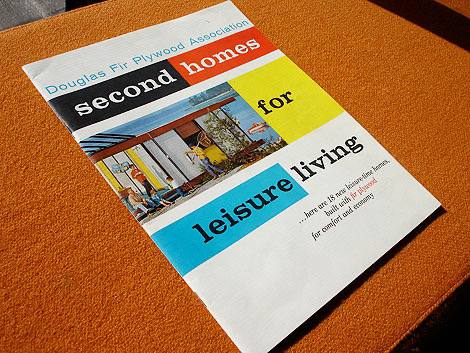
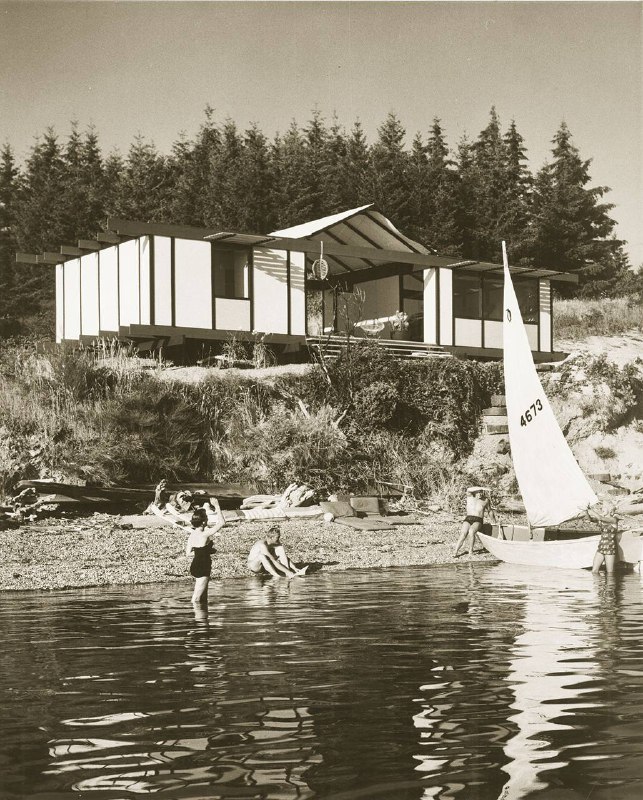

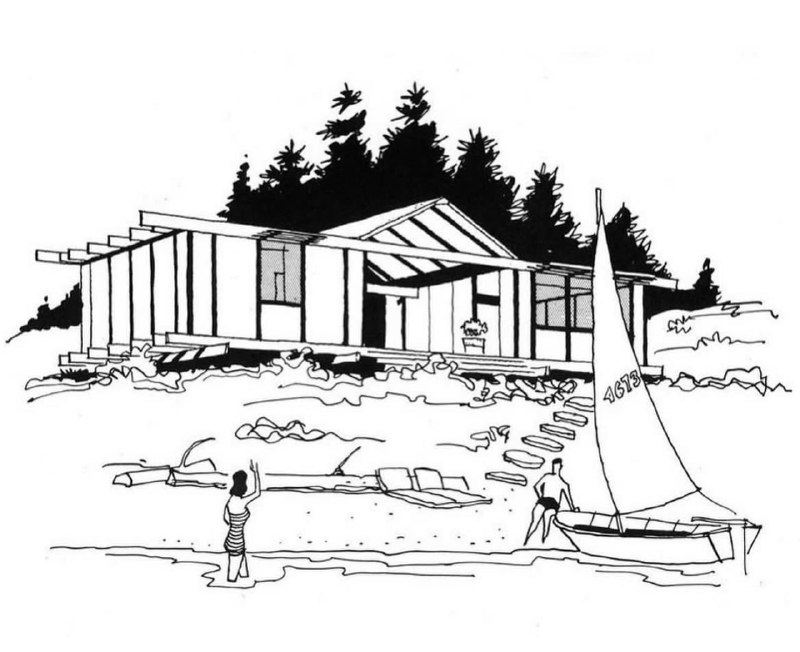
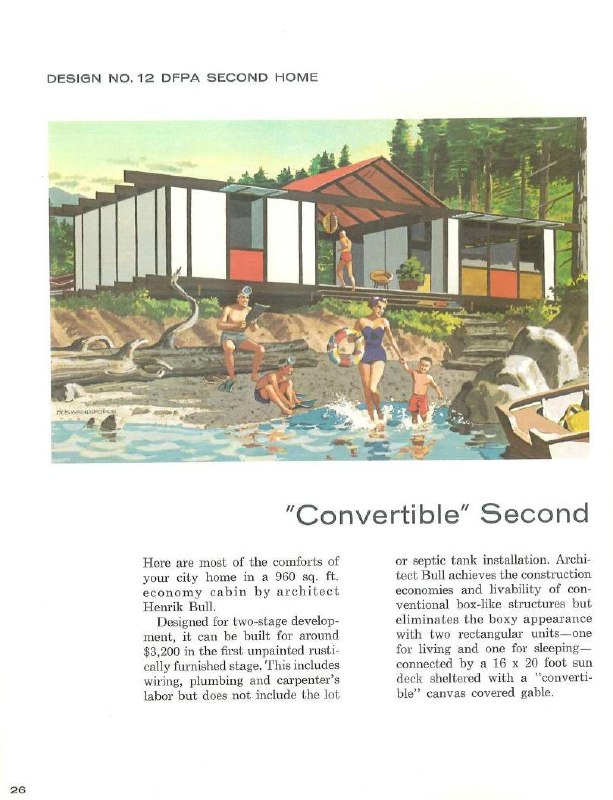
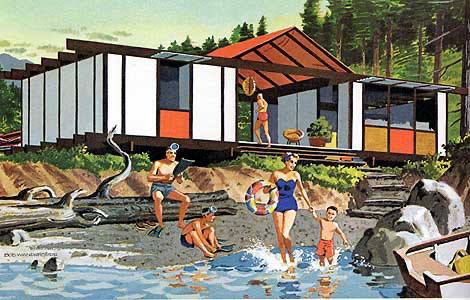

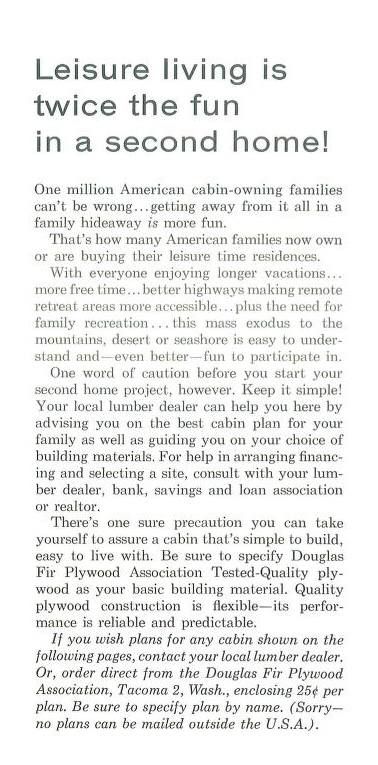
Share with your friend now:
group-telegram.com/midcenturymodern/16883
